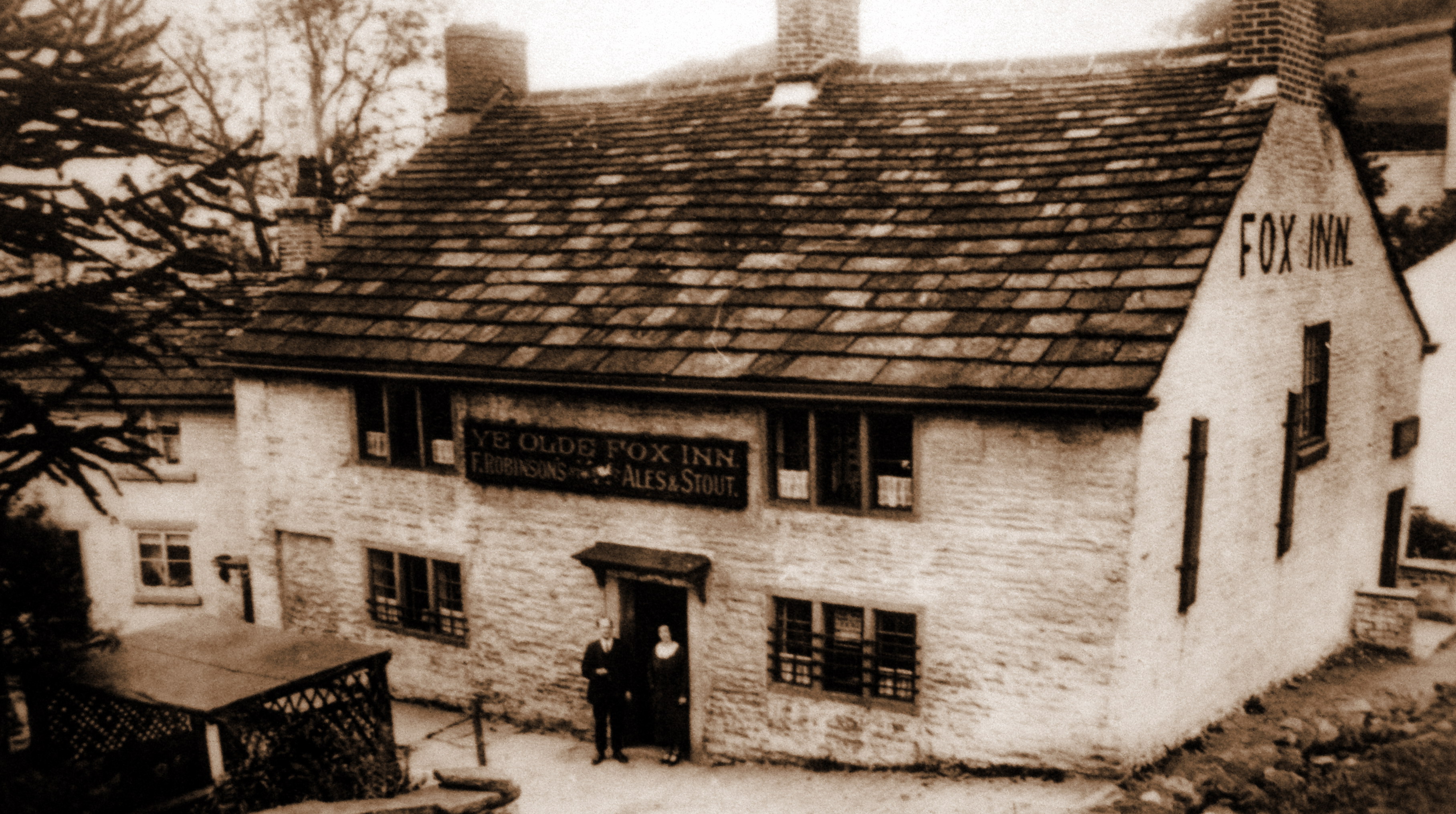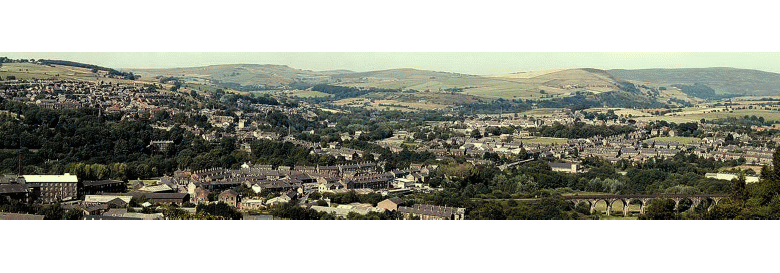Brookbottom is a small, but popular hamlet around a mile from New Mills. It consists of a few houses and scattered farms, a public house The Fox Inn and a Methodist Chapel built in 1874. Only the single track lane from High Lee is metalled, the other lanes to Strines, Mellor Hague Bar and Whitle are unmade and in parts need great care to pass.
An article from 1961 made the following observations:-
WATENDLATH in the Lake District, Buckler's Hard near the New Forest and Upper Slaughter in the Cotswolds are hamlets whose attraction to summer visitors is probably enhanced by their small size. Although it has not their charm and lure, Brook Bottom near New Mills is a Peak hamlet completely overlooked by the guide books, but remembered with regard by travellers who are attracted by the miniature.
The setting of a miniature often enhances its attraction and Brook Bottom has a splendid setting. Its brimstone cottages, some whitewashed, cluster along the valley bottom of a steep-sided wooded clough on the sunward side of Cobden Edge with the fine Strines Vale below. The brook there joins the Goyt.
Above the hamlet a lane climbs to the Edge and beyond the Edge are the moors. Flanking the clough on the hillside are farmed fields and small woods with occasional folds and farm houses. Across the broad river valley are the Lyme Park lands and Black Hill. Brook Bottom has as delectable a setting as a shy secluded hamlet could wish for.
 Whichever way you come, whether along the old hill-terrace lane between Beard Hall, New Mills, and Mellor Hall, or downhill from the moors by Capstone or by Shaw, or uphill from the valley by Hague Bar or Strines, the discovery of the eyrie of houses clustering in the steep-sided slough is unexpected. You cannot see the grey-stone whitewashed hamlet until you are almost in it. Whichever way you come, whether along the old hill-terrace lane between Beard Hall, New Mills, and Mellor Hall, or downhill from the moors by Capstone or by Shaw, or uphill from the valley by Hague Bar or Strines, the discovery of the eyrie of houses clustering in the steep-sided slough is unexpected. You cannot see the grey-stone whitewashed hamlet until you are almost in it.
When you are in it, you can see neither valley nor fields, only the hill behind and the sky above.
The small windows close under the eaves indicate that weavers lived in many of the cottages when they were built. They probably worked on the land also until one of the first calico-printing works in the world was built in the valley below. This Strines mill gave employment to most of the people in the hamlet during the last century. A hundred years ago the opening of Strines station made the district more readily available to Manchester ramblers. During the last thirty years several cottages were weekend retreats for Lancashire city workers.
The only thing that hurries through Brook Bottom is the brook, and it is discreetly hidden underneath some cottages after it has jumped down from the moor in a series of miniature cascades. Its importance is greater than its humble appearance indicates.
Since 1934 it has been not only the county boundary, but also the boundary between the Provinces of Canterbury and York, between All England and England. Some say the stream once divided Northumbria from Mercia: it may be so.
 The church and the inn are the centres of community life for the neighbourhood. A violin, clarinet, double-bass and cello, played by Beards and Beeleys, two old Brook Bottom families, accompanied the church singing when the building was opened ninety years ago: it was then lighted by oil lamps. The church and the inn are the centres of community life for the neighbourhood. A violin, clarinet, double-bass and cello, played by Beards and Beeleys, two old Brook Bottom families, accompanied the church singing when the building was opened ninety years ago: it was then lighted by oil lamps.
Mr. John Potts, now in his eighties, has told me of the Sundays of his youth when only horse-drawn traffic, apart from the occasional bicycle, slowly used the valley road. After morning service a group of youths walked down by the clough to Strines Vale and for a couple of miles followed the beautifully wooded meanders of the river before returning uphill home to lunch. After Sunday School they climbed to the top of Cobden Edge with the Cheshire plain to the west and a horseshoe of fine hills round the horizon.
Furness Vale or Birch Vale or elsewhere were the objects of a walk after evening service. 'We walked and talked, and thought nothing of it,' he remarked. 'They were great days.' Mr. Potts has recently celebrated a second Silver Wedding.
 Shepherds and farmers from the hill above come down to the eighteenth-century Fox inn. Its low rafters might tell merry tales of forgotten Christmasses when local-bred mutton was provided for jocund evenings. Shepherds and farmers from the hill above come down to the eighteenth-century Fox inn. Its low rafters might tell merry tales of forgotten Christmasses when local-bred mutton was provided for jocund evenings.
Across the lane from the inn are swings and see-saws for the children. Their day school is down in Hague Bar.
An unusual cavalcade that has its niche in history rode along the lane over the brook on 31st August, 1748. John Wesley had preached at a nearby farmhouse, the Bongs. He left on horseback for Chinley where his friend, John Bennet, who was riding with him, lived. Also riding with them was Grace Murray who had nursed both the Johns through serious illnesses in Newcastle. Both were deeply attracted by her and as Wesley, with probably a group of local farmers and weavers, rode towards New Mills along the hill-terrace lane with its wide prospect over the Goyt valley, he would be pre-occupied with his visit to his rival's home.
Bennet urged his suit a few days afterwards and, said Grace, 'I "partly'' gave him my promise.' A year later, to Wesley's chagrin, Bennet married her.
The valley they saw, with more trees and fewer buildings than it has today, was so fair that it is said that Wesley commented that he did not expect to see a finer prospect than that from the Edge even in Paradise. A farm near the summit, Paradise Farm, was so named, it is said, because of Wesley's praise.
 Seventy years later the travelled John Farey wrote: 'New Mills Dale is the most singular and striking gritstone valley, which I have anywhere witnessed.' Seventy years later the travelled John Farey wrote: 'New Mills Dale is the most singular and striking gritstone valley, which I have anywhere witnessed.'
The valley is crossed by an old track which Roman soldiers probably made use of when they journeyed from Aquae Arnemetiae (Buxton) to Ardotalia (Glossop), when the thickly wooded hillside was a haunt of eagles and wolves. The track leaves the Roman road at Higher Disley, crosses the Goyt, and then makes, through Brook Bottom, for the summit of Cobden Edge and north away over the moors. Brook Bottom people still call the lane to the summit, by Capstone farm, the Roman road! This spring it was watched by a pair of kestrels wind hovering for minutes at a time, as though posing for field-glasses.
The miniature village has its miniature skyscraper. For a brief space when it turns towards Mellor the lane is like a continental side street. On one side is a five-storey house with its entrance three storeys up through a garden higher up the lane. At the top of the rise is Highcliff Farm noted for the high grade poultry reared by Mr G. A. Richardson, and further along is Lower Cliff for a long time farmed by the Moults of Mellor Hall, relatives of Thomas Moult the Derbyshire writer born in the Hall. More recently Mellor Hall was the home of Colonel and Mrs Norbury, sister to Gwen ffrangcon Davies, the actress.
Brook Bottom is a snug hamlet, winter and summer, for the steep clough sides protect it from undue encroachments of the weather. They also protect it from undue modernisation. Less than a lifetime ago all water was carried by yoke from a field up Mellor lane and the cottages were lighted by candles or oil-lamps.
There was no letter-box or telephone kiosk then. Such journeys are happily unnecessary now. The cottages are sensibly modernised, painted spick and span, pleasant places especially when the summer flowers are in full bloom. Yet the garish and crude vociferation of some aspects of contemporary life has been quietly kept at bay.
The most important event in the hamlet's story since the station was built in the valley below is soon to take place. The lane from New Mills is to be made up as a metalled road. It is the old highway to Marple used before Samuel Oldknow built the valley road in the first decade of last century, and Brook Bottom ratepayers are pleased they are to have this amenity. Although more travellers will probably visit the hamlet, it will remain almost a cul-de-sac, and the new road cannot detract much from the quiet seclusion of this Peak miniature.
 
 |









 Whichever way you come, whether along the old hill-terrace lane between Beard Hall, New Mills, and Mellor Hall, or downhill from the moors by Capstone or by Shaw, or uphill from the valley by Hague Bar or Strines, the discovery of the eyrie of houses clustering in the steep-sided slough is unexpected. You cannot see the grey-stone whitewashed hamlet until you are almost in it.
Whichever way you come, whether along the old hill-terrace lane between Beard Hall, New Mills, and Mellor Hall, or downhill from the moors by Capstone or by Shaw, or uphill from the valley by Hague Bar or Strines, the discovery of the eyrie of houses clustering in the steep-sided slough is unexpected. You cannot see the grey-stone whitewashed hamlet until you are almost in it. The church and the inn are the centres of community life for the neighbourhood. A violin, clarinet, double-bass and cello, played by Beards and Beeleys, two old Brook Bottom families, accompanied the church singing when the building was opened ninety years ago: it was then lighted by oil lamps.
The church and the inn are the centres of community life for the neighbourhood. A violin, clarinet, double-bass and cello, played by Beards and Beeleys, two old Brook Bottom families, accompanied the church singing when the building was opened ninety years ago: it was then lighted by oil lamps.
 Seventy years later the travelled John Farey wrote: 'New Mills Dale is the most singular and striking gritstone valley, which I have anywhere witnessed.'
Seventy years later the travelled John Farey wrote: 'New Mills Dale is the most singular and striking gritstone valley, which I have anywhere witnessed.'
